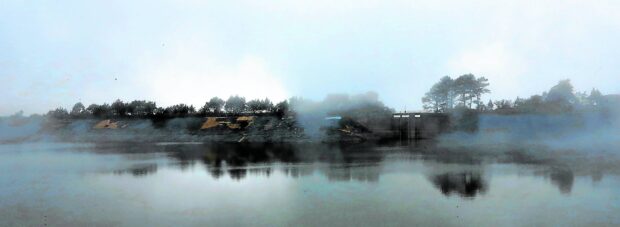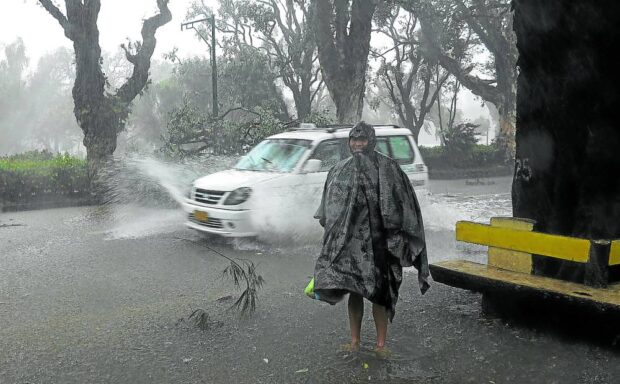Baguio urged to tax tourists for water use

RAIN BASIN | Baguio City has been rationing water since the late 1980s because the supply pumped out from its aquifers is not enough for its growing population. But the city’s high rainfall remains an untapped resource. The Mt. Santo Tomas Rain Basin built by the American colonial government, shown in this photo taken on Dec. 31, 2014, has augmented demand for decades. (File photo by EV ESPIRITU / Inquirer Northern Luzon)
BAGUIO CITY, Benguet, Philippines — Collecting taxes from tourists and transients for the water they consume may help finance new rainwater-harvesting projects that can augment the city’s dwindling water supply, Salvador Royeca, general manager of the Baguio Water District (BWD), said on Monday.
Royeca proposed this option to the city council to help the local government deal with the impending El Niño phenomenon toward the end of the year and the first months of 2024 and the persistent water supply shortage.
Although the city receives high volumes of rainfall each year, runoff rainwater has not been replenishing its aquifer fast enough due to deforestation and its concrete pavements, said Royeca when he discussed the city’s water situation during the council’s regular session.
Baguio, Eastern Samar, and Surigao del Norte receive the highest rainfall in the country, with the summer capital itself taking in as much as 4,064 millimeters (160 inches) of rain annually, according to data supplied by Program Boondock, a collaboration of Cordillera universities undertaking climate-related projects financed by the Department of Science and Technology.
The Mt. Santo Tomas Rain Basin, which was constructed by American engineers in the early years of the 20th century, is Baguio’s largest rain collection facility with a 700,000 cubic-meter capacity. But the reservoir water had been preserved this year to be used during El Niño.
Article continues after this advertisementRoyeca recommended collecting water tax in the form of additional environmental fees from the city’s seasonal guests; or a “polluters’ tax,” to be paid by high-impact businesses that consume huge amounts of water.
Article continues after this advertisementHe said this would help raise capital for the construction of more rainwater-harvesting facilities.
The fees to cover water consumption by tourists and nonresidents are meant to be their contribution to sustaining Baguio’s water resources, Royeca stressed.
According to him, the preservation of Baguio’s remaining watersheds in its forested areas is also crucial. Government foresters have estimated that Baguio still has 2.5 million trees, mostly in the city’s remaining protected forests.
Rationing

MOUNTAIN FLOODING | Typhoon Lando (international name: Koppu) in 2015 dumped more than 40 inches of rain, flooding Burnham Park in Baguio City. (File photo by EV ESPIRITU / Inquirer Northern L
Parts of Baguio rely on rationed water on certain days of the week because highly populated neighborhoods like Quirino Hill and Quezon Hill do not have their own underground water sources, unlike other sections of the city, Royeca explained.
BWD hydrologists have failed to discover and develop safe water sources in these areas, so water pumped from other districts is diverted to these communities, he said.
This year, the BWD has managed to sustain the city’s daily water demand of about 45,066.03 cubic meters by generating 44,607.43 cu. m. Its latest projections indicated an improvement in supply by 2029 (53,090.38 cu. m. of water for a demand of 52,891.32 cu. m.) and 2031 (57,953.87 cu. m. for a demand of 55,452.41 cu. m.).
But the annual influx of tourists between December and May generates “artificial demand” of roughly 20 percent more than the available supply, Royeca said.Recharging
Baguio has a population of 366,358 (as of the 2020 census), but an urban carrying capacity report commissioned by the National Economic and Development Authority in 2019 said the city’s “daytime” population could rise to as high as 700,000 due to tourists, out-of-town vendors or entrepreneurs, and students residing in neighboring towns in Benguet and the Ilocos region.
Certeza Infosys, which conducted the carrying capacity report, said “the population threshold” of Baguio’s water supply is 267,546 consumers, indicating it has already been breached.Program Boondock has been testing an artificial rainwater recharging system at Baguio’s Burnham Park and in the strawberry fields of La Trinidad town in Benguet.
But the BWD has used the same reengineering principle in some of Baguio’s watersheds by constructing ditches to direct rainwater directly to natural aquifer recharge areas in the forests, Royeca said.
A small company recently offered to harness the water collected at Burnham Park, including its man-made lake, said Councilor Mylene Yaranon.
Councilor Leandro Yangot has also filed a resolution that encourages big-water consumers like golf courses to build massive rainwater reservoirs for the public.
Major companies have offered to put up bulk water projects for Baguio but the cost may be prohibitive, Royeca noted.
A Manila-based distributor offered to supply Baguio with 20,000 cu. m. of daily water for three years, but it would require consumers to pay an additional P99 for each cubic meter of water they consume, he said.